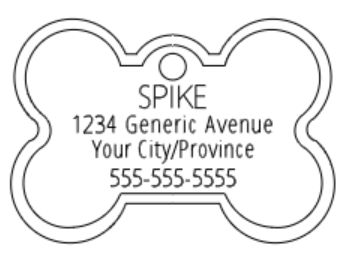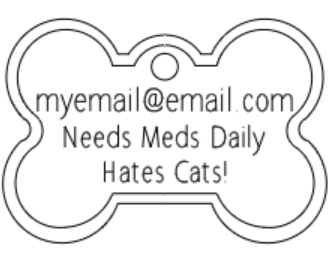
What’s on your dog’s tag? Having the right ID on your dog can be an invaluable tool for helping get them home quickly. Learn what to put on a dog tag to help them find their way back to you.
You’d do anything to keep your dog safe, but you may be overlooking one of the most important tools for making sure your dog can always find his way home: A dog ID tag. We can help you figure out what to put on a tag to ensure that your dog has the right info to get home safely.
Some people love their pups so much they have portraits made from sites like Instapainting. (And why not? Dogs tend to be better friends and family members than some people, right?).
If your pet is part of your family member, then take the right precautions to make sure they can always find their way home. What to put on a dog tag?
Why Do Dogs Need ID?
Your dog will always be a puppy to you. Rambunctious, playful, and curious at heart, dogs are always ready to explore, but sometimes, their curiosity can get them into trouble. No matter how old your pup is, there is always some mischief that could put the animal in a dangerous situation.
Let’s say you’re on vacation, walking your pup in an unfamiliar city, and a mischievous squirrel skitters down from a tree. Suddenly your dog may forget he’s on a leash and explode like a barking rocket after the tree rodent.
Teach your dog good walking behaviours with tips from How to Stop Your Dog From Pulling on Leash.
Maybe you were able to hold the leash, maybe you weren’t. Maybe the squirrel made it to the tree, maybe it couldn’t, and ran down an alley. Either way, your dog vanished. What now?
Without a proper identification tag, it is going to be very difficult for anyone who finds your dog to get in touch with you. Additionally, certain IDs like city licenses or vaccine tags may be mandated by your local government.
Without the right ID, your dog could end up being lost for a lot longer or may end up at the pound with no way to find his family.
Helping Others Help Your Pup
Hopefully, you are protecting your dog with a collar that has the right information on its dangling dog tags. But what to put on a tag; that’s the question! We’ll go over some of the most common and most important suggestions for putting the right information on your dog’s ID tag.
When your dog gets lost, you hope that someone will find them quickly, whether it’s a neighbour, a stranger, or even the dog catcher. They are safer with a human than wandering around on their own.
To make sure they are quickly brought home, there are a few ways to make your dog easily identifiable:
- Dog ID Tag
- Micro Chips
- Tattoos
Each type has its pros and cons, and many pet owners prefer to use multiple identification methods to ensure their pet’s quick homecoming if they ever get lost. Below is a quick breakdown of each type of identification to help you decide which ones are right for you.
Dog ID Tags
.webp?width=792&height=528&name=bull-terrier-with-green-dog-tag%20(1).webp)
The most preferred method of identification tag for dogs is dog ID tags. They are cheap and easy to see, so when your dog gets spotted by a passerby, they will immediately notice the tags and know that your dog is lost.
Benefits of Dog ID Tags
There are many reasons that you may prefer a dog ID tag, and we recommend that you have an up-to-date pet ID tag for your dog regardless of whatever other identification methods you choose. Here are the benefits and disadvantages of dog ID tags:
Cheap
The price range of dog ID tags can vary, but they are in general, very affordable. You can choose from a basic aluminum tag for the most function, or something a little more fashionable if your dog prefers a little aesthetic flair. The fancier the tag, the greater the cost may be.
The lower cost of ID tags makes them easy to replace if they get damaged or if your contact info changes suddenly.
Customizable
ID tags can be customized to share specific information about your pet that may affect how a stranger cares for them until they can be returned to you safely. Additionally, your contact information may change several times over the course of your dog’s life, and sometimes those changes may be temporary.
You can customize spare ID tags for specific trips or situations. For example, if you have to leave your dog with a friend, you may want them to have more accurate information so they can be returned to the appropriate person. What info is on dog tags?
Creative Dog Tag Ideas
While a fun message isn't required, it is fun. Here are 10 of our favourite funny dog tags ideas to give the next person that finds your pooch a chuckle:
-
-
-
- Not All Who Wander Are Lost. Except Me. Please Call My Mom!
- Got Lost Looking for B*tches.
- Oh, Sh*t! I'm Lost
- My Mom is Freaking Out Right Now!
- Have Your People Call My People
- If You Can Read This, I Will Lick You!
- I Seem to Have Misplaced My Hooman...
- I Escaped... Muahaha!
- Can You Call My Mom? I Don't Have Thumbs.
- Professional Escape Artist
-
-
Non-Invasive
Unlike microchips or tattoos, Pet ID tags do not require any needles or procedures that could have adverse reactions. They simply dangle from your dog’s collar. They are small and light enough that your dog will quickly get used to them.
Easy to Read
Pet ID tag can be deciphered by anyone, unlike other identification methods. Anyone who finds your dog can read the info and get in touch with you immediately. This will make it more likely that a stranger will help.
What to Put on a Dog Tag
To ensure that your dog is appropriately handled and returned to you, you need to know what to put on a tag. You can be as plain or clever as you’d like, but make sure that the vital information is there. Here are some things you might consider for your dog’s ID tag:
Their Dog's Name
This one’s pretty straightforward: as you’re exploring what to put on a tag, don’t forget the pet’s name. Put it in either bold letters or a larger font right at the top of the tag.
A dog’s eyes might get big and they might bark or whine, but dogs think about their situation. They can be trained extensively and can learn. So even if a stranger calls their dog's name, your pup is likely to recognize it and be more obedient. If that dog's name is front and center on the pup’s tag, it makes things easier for everybody.
Additionally, your dog may be less nervous with their temporary babysitter if they can call them by their dog's name. This might make the experience less stressful for everyone involved
Phone Number
Obviously, when you’re exploring what to put on a tag, your contact number should be at the top of the list. While not everyone likes giving out their contact number, it is the most convenient and immediate method for someone to contact you should they find your dog.
You may even want to put a few different phone numbers on the tag to ensure that someone else could be contacted if you are away from your phone.
You don't pay by the letter with our tags, so you can put multiple phone numbers on a single tag if you'd like. Keep in mind, the more info you want to add to the tag, the bigger the tag may need to be to maintain legibility.
Home Address
So what to put on a tag may differ from region to region. If you live in a small town, then your dog may not get far, so you can be a little more vague with your address, but the larger the area, the more specific you may need to be, potentially all the way up to the postal code and country.
In some situations, a full address may not be all that helpful, like if you are vacationing with your dog in another province or country. In this case, a city and country may be enough to help someone get your dog back to you.
Email Address
An email address, provided it’s not overly long, is also a great answer to the question “what should I put on dog tags?” If someone can’t call you, email is a great way to go. Email also allows them to send you something, like a video or a picture, through email to verify that they have your pet without incurring any costs that may be associated with texting these multi-media and social media messages.
Your email may be too long to fit on dog tags, so it's not a necessity, but if it fits, it's a good idea. Don't stress too much about fitting everything on the tag, and instead, think more about putting the most important information that will legibly fit on the dog tag.
Medical Needs
Many dog lovers forget medication when they’re considering what to put on a dog. Especially given the variety of breeds out there, and how those breeds are made, it’s considerable that some pups have “built-in”, if you will, medical issues.
If you can fit pertinent information on there, you should. It could be very helpful; especially if your pup is lost for a while. Think of their tag as a medic alert bracelet. Conditions like diabetes or food allergies can be noted to ensure that whoever finds your dog knows they may need to be cautious about what they feed your pet.
Other Relevant Information
Lastly, you want to be sure any other relevant info is included when you’re thinking about what to put on a tag. Any behaviours that your dog may show that might surprise a stranger could be added to the tag.
For example, if your dog is reactive around cats, that might be something a fellow pet lover might want to know before potentially bringing your dog home if they need to.
What an Effective Dog Tag Looks Like
Not everything listed above needs to go on every tag. You pick the information that is most relevant to your dog and your dog's situation. If you want your dog tag to be thorough, then what to put on a tag may require a little strategy. This is a possible template:
Front

Back

Now certainly, that’s a lot of info to fit on a tiny tag, so you want to be strategic. You may have to condense things, stick to tags that allow engraving on both sides, or buy two tags. Perhaps instead of putting the full dog's name of a medication, you just put the words - meds needed.
Even with some abbreviations, you may still need to cut out information to fit the most relevant info on the tag. Maybe pull out the email or the special advisements if they aren't absolutely required. A lot of times, pet owners use just a dog's name and cell number to make sure it's easy to read.
Ideally, you'd want a little more info than that, but if you have a very small dog, they'll need a very small tag, which means you can only put a very small amount of info on it. Additionally, you can certainly have multiple tags printed if more information is required.
Dog Microchips
.webp?width=792&height=528&name=vet-checking-dog-for-microchip%20(1).webp)
A very common practice for dog owners is microchipping their pets. This involves a small microchip being injected under your dog’s skin with a needle. This small chip is then registered, allowing any vet’s office to scan the chip, pulling up the animal’s contact info.
Unlike a dog ID tag, a microchip can be damaged or lost, so even if he loses his dog collar and tags, he can still be returned to you quickly.
The cost to microchip a pet through your vet is usually around $70 in Canada, but you may be able to find a better price through your local SPCA. They often offer some basic services, like microchipping or spaying/neutering for cheaper to encourage pet owners and potential pet adopters to choose these responsible pet ownership practices.
Today, microchipping technology uses something called an ISO standard. This allows microchips of different frequencies to be scanned by any microchip scanner. If your pet is lost in a different city, or even country, their chip should be scannable.
While microchips are very safe, they do have a downside. Microchips can shift under your dog’s skin, moving to a different location. Though it won’t harm your dog, it will make the chip harder to find and scan. Vets know to look in a wider search area when looking for a microchip, just in case it has moved.
According to Dogsnaturallymagazine.com, there may be more serious side effects of microchipping your dog:
"Medical reports and scientific studies reveal that dogs and cats have developed aggressive cancerous growths at the site of their microchip implants."
While this is concerning, it is extremely rare. Though microchipping is an effective method for identifying your pet, it's not your only choice. Talk to your vet if you have concerns about the safety of microchipping your dog.
Dog Tattoos
Your dog might look pretty rad with some sweet tats, but the tattoos that we are talking about are for identification purposes only. This is a less common practice these days, but it’s absolutely still an option.
The tattoo is written in code, so you may not know what it says, but the serial number will be registered, allowing a vet to look up the file associated with the phone number.
You may not like a good idea of a tattoo for your dog. Rest assured, the procedure is minimally invasive, and not very painful. It’s often done with your dog fully awake. Though generally safe, there is a small risk of allergic reactions. It’s very rare, and usually not serious.
Another factor is that just like human tattoos, the ink can fade and stretch with the skin, which could make it harder to read as your dog gets older. To make the ink easier to read, swipe a cotton swab with a small amount of rubbing alcohol across the tattoo. The ink will look a little clearer, allowing you to read the full code.
Special ID tag for Travelling with Dogs
.webp?width=792&height=528&name=lost-dog-holding-leash%20(1).webp)
When the issue of what to put on a tag presents itself, you’ve got a lot of options. Ultimately, it’s up to you, but if you’re going to be traveling regularly with your animal, you want it to be easy for those in another city to contact you should your pooch decide to be mischievous and run off after a squirrel or something.
Your regular dog tag may have your home address or home phone number, but that won't be of much help in a different country. Cell phone numbers and email addresses are going to be much more relevant in these situations.
If you are traveling in a country that speaks a different language, then you may want a tag engraved with your pet's information in the appropriate language. If whoever finds your dog doesn't speak or read English, then they may have a heck of a time returning your lost pooch.
Frequently Asked Questions
Why are pet ID tags important for my dog's safety?
Pet ID tags are crucial because they provide a quick way for someone to contact you if your dog becomes lost or is found by a Good Samaritan, increasing the chances of a safe return.
What information should I include on my dog's ID tag?
Include your dog's name, your phone number, and your city or address. Also, you can add other essential details like a secondary contact number or medical information if your dog has special needs.
Should I include my dog's name on the ID tag?
Yes, including your dog's name can help establish a personal connection with anyone who finds your pet, making it easier for them to comfort your dog and call them by name.
Can I use a microchip instead of an ID tag?
While microchips are valuable for permanent identification, they require a special scanner. ID tags are more immediate and visible, providing an easy way for anyone to contact you without special equipment.
How often should I update my dog's ID tag information?
Regularly check and update your dog's ID tag if any contact information changes, such as your phone number or address. This ensures that the information is always accurate.
What should I do if my dog loses their ID tag?
If your dog's ID tag is lost or damaged, replace it promptly to maintain their safety. Temporary tags or collars with your contact information can serve as a backup while you obtain a new permanent ID tag.
.png?width=200&height=66&name=logo%20(1).png)




